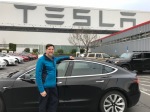A 3 minute read for Battery, Vehicle and Charging Station News
#1 – Georgia Public Service Commission Approves Pilot for Used EV DC Charging Station Power

July 16, 2019 – The Georgia Public Service Commission signed off on commissioner Tim Echols’ proposal to have Georgia Power and the commission work together to explore whether used batteries from electric vehicles could be re-purposed for fast-charging EV stations. Echols said there is an excess of partially-used products, particularly Nissan Leaf batteries, that still have a lot of energy left. Using these batteries for a pilot could help expand EV charging availability throughout the state while insulating the grid from electricity demand spikes. “There is no recycling available for these batteries at this time,” Echols said during the meeting. “Given we’re about to approve 80 MW of new lithium-ion batteries, it’s in our benefit to do a pilot program to see if it will work to reuse these batteries for a purpose that benefits the public and our grid and the Georgia community in general.” The program would be capped at $250,000 in costs passed down to ratepayers. ttps://www.spglobal.com/marketintelligence/en/news-insights/trending/UlMh2otzI0d9KO4FwGjEXQ2
#2 – Audi E-Tron Debuts in North Georgia

July 11, 2019 – Members of the Audi Club of Georgia gathered for their regular club meeting at Audi North Atlanta Roswell and for their introduction and test drive of the new Audi E-Tron SUV with 208 miles of all electric range powered by a 95 kWh battery back and two electric motors mounted on the front and rear trans axles. Die-hard Audi owners (most owned 3+ of the German Marquee) were positively impressed by the instant acceleration, regenerative braking and all of the qualities that make the SUV an Audi.

Re-charging is handled via Level 1 (110-120V), Level 2 (240V ) and DC charging (480V+ with CCS cord) with input rated at 150kW delivering 100 miles of range in 10-15 minutes. Audi is part of Volkswagen of America, whose Electrify America unit is deploying fast charging stations under the Partial Consent Decree. Priced from $74,900 to $90,000 the E-tron is competitively priced to the only large SUV competitor, the Tesla Model X (305-325 miles all electric range). https://www.audiusa.com/models/audi-e-tron
#3 – Electrify America Metro Atlanta Charging Network Cycle 2 Expansion

July 12, 2019. From Chris Campbell, Secretary EV Club of the South via their FaceBook page:
“Those of you clamoring for DCFC stations on the southside of Atlanta will be happy to read this. Electrify Atlanta will be expanding its presence in metro Atlanta significantly during the “Cycle 2” phase of their long term effort, and they have already reached out to the City of Atlanta and other organizations for guidance. Travis Buholtz [from the City of Atlanta Sustainability EV Infrastructure Fellow] came to our monthly meeting on June 19th and briefly showed us this map of EA’s proposed locations, and he encouraged us to share it. This map is focused on City of Atlanta, generally ITP. So don’t bother pointing out that it’s missing a zillion stations in the suburbs.” https://www.facebook.com/evcots/notifications/
Note Access to EV Club of the South FB Page requires Club approval



 On my last trip to the Bay area, I was lucky enough to score a rental of a brand new Tesla Model 3 through Turo, the “Air BNB” of personal owner car sharing. Over a four day, 312 mile rental, I had the opportunity to put the Model 3 through its paces traversing the highways and byways of Silicon Valley. This review continues my first blogpost of the Model 3:
On my last trip to the Bay area, I was lucky enough to score a rental of a brand new Tesla Model 3 through Turo, the “Air BNB” of personal owner car sharing. Over a four day, 312 mile rental, I had the opportunity to put the Model 3 through its paces traversing the highways and byways of Silicon Valley. This review continues my first blogpost of the Model 3:
You must be logged in to post a comment.